In Las Vegas, upholstered furniture is subjected to unique environmental pressures that accelerate soiling and wear. The dry climate, pervasive dust from the surrounding Mojave Desert, consistent high-volume traffic, and the demands of powerful residential cooling systems require a tailored maintenance approach that goes beyond standard cleaning practices found in more temperate or humid regions. Your furniture, a significant investment in your home’s comfort and aesthetics, serves as an environmental sponge, continually absorbing the specific pollutants of the Las Vegas Valley.
The Impact of Desert Air and Urbanization on Fabric
The primary threats to the longevity and cleanliness of upholstery in the Mojave Desert stem from three critical local factors: the fine desert dust, the prevalence of oily soil contamination, and the resultant deterioration of indoor air quality (IAQ).
The Abrasive Force of Desert Dust
The most significant and often underestimated threat is the fine, abrasive desert dust and sand. Unlike regions with higher humidity where dust particles often bond with moisture and fall quickly to the floor, the extremely low ambient humidity in Las Vegas allows microscopic particulate matter—including fine silica, sediment, and construction debris—to remain suspended in the air for extended periods. This airborne grit infiltrates homes relentlessly, often circulating through HVAC systems even when windows are sealed.
Once this particulate matter settles and is trapped deep within fabric fibers, it becomes highly destructive. Every time someone sits, shifts, or moves on the upholstered item, these sharp, angular particles are pressed into the textile. This action mimics sandpaper, grinding against the structural threads of the fabric. This process is the leading cause of premature wear, resulting in a noticeable thinning of the fibers, a loss of plushness, and a permanent dulling of the original color long before the fabric should naturally degrade. Addressing this embedded grit through thorough dry extraction is the non-negotiable first step in effective Vegas upholstery care.
Oily Soil and the High-Contact Vegas Lifestyle
The second major threat involves the accelerated build-up of oily soil contamination on high-contact areas—a problem exacerbated by the intense heat and dry climate. To combat the desert’s aridity, Las Vegas residents often use more lotions, sunscreens, and moisturizing cosmetics. Combined with the natural transfer of body oils and sweat in a consistently warm environment, these residues stick tenaciously to fabric fibers, especially synthetics.
This oily film serves as a powerful adhesive layer, effectively binding the abrasive desert dust to the fabric and creating a tenacious, multi-layered soil known locally as Sin City Soil or Embedded Desert Contamination. This combination is responsible for the dark, stiff, or greasy appearance on armrests, headrests, and seat edges. Household vacuums cannot break this chemical bond, and attempting to clean these spots with improper methods often only spreads the oil deeper into the fibers. Only professional pre-conditioning agents, formulated to safely emulsify this specific blend of oil and mineral dust, can prepare the fabric for successful extraction.
The Upholstery-IAQ Connection in a Closed-Loop System
Your home’s upholstered furniture functions as a large, inefficient air filter. In a city where the air conditioning runs for much of the year, homes are tightly sealed, leading to the continual recirculation of indoor air. This closed-loop system causes your upholstery to trap:
- Regional Allergens: Including desert-specific pollens and airborne molds.
- Domestic Pollutants: Such as pet dander, shed skin flakes (food for dust mites), and VOCs (volatile organic compounds) released from building materials or cleaning products.
- Construction Particulates: Particularly high in a constantly growing metro area.
As these contaminants accumulate, they are continually re-released into your breathing space whenever the furniture is used. For allergy sufferers or those with respiratory sensitivities, this can mean year-round discomfort. Deep cleaning not only restores the look of your furniture but is a critical component of maintaining superior Indoor Air Quality (IAQ), ensuring your home is a truly healthy sanctuary from the outside environment.
Maintenance and Longevity in an Arid Climate
Protecting your investment and maximizing the lifespan of your upholstered pieces in Las Vegas requires proactive, specific care.
Choosing and Caring for Fabric
Understanding how fabric types react to the Vegas climate is key to longevity:
- Synthetics (Polyester, Microfiber): These are popular due to their durability and resistance to wear. However, their petroleum-based composition gives them a natural affinity for oil-based soils (body oils, lotions). When cleaning, it is essential to use specialized, high-pH detergents to effectively break down these oils, followed by a complete rinse to prevent a sticky residue.
- Natural Fibers (Cotton, Linen, Silk): These breathable fibers are comfortable but are more susceptible to drying out and becoming brittle in the arid environment. They demand controlled, low-moisture cleaning to prevent fiber damage and require rapid, powerful extraction to minimize dwell time.
- Leather and Vinyl: The intense dry air and UV exposure are leather’s worst enemies. Consistent, long-term exposure leads to the loss of natural oils and moisture, causing surface cracking, fading, and peeling. Maintenance is a two-step process: cleaning off surface dirt and body oils, then immediately applying professional-grade leather conditioners designed to restore moisture and flexibility, offering a protective barrier against the sun’s intensity.
Recommended Cleaning Frequency for Desert Living
Given the abrasive nature of desert soil, professional cleaning should be scheduled more frequently than the national average to mitigate fiber damage and extend the life of the upholstery.
| Environment | Primary Challenge | Suggested Upholstery Cleaning Interval |
| High Traffic (Children, Pets, Frequent Entertaining, Home Office) | Maximum abrasive soil, oil transfer, and allergen load. | Every 6 to 12 months |
| Normal Traffic (2-4 Adults, Moderate Use) | Steady accumulation of body oils and mineral dust. | Every 12 to 18 months |
| Low Traffic/Guest Furniture (Formal Rooms, Rarely Used) | Primarily dust infiltration and UV exposure. | Every 24 months |
The Deep Cleaning Process: Optimized for Las Vegas
A successful upholstery cleaning in this market must be a scientifically controlled process that prioritizes soil removal, safe drying, and residue elimination. The methodologies used must directly counter the specific challenges of the local environment.
1. Advanced Soil Analysis and Pre-Inspection
The cleaning process begins with a meticulous technical assessment. The technician identifies the fabric fiber type (e.g., natural cotton vs. synthetic polyester), conducts a colorfastness test to prevent dye migration, and assesses the soil type—distinguishing between the dry, abrasive desert dust and the stubborn, sticky oily soil. This determines the precise solution chemistry and water temperature to be used.
2. Maximized Dry Soil Removal
Utilizing commercial-grade vacuums equipped with high-efficiency (HEPA) filtration, the technician performs an intensive, high-powered dry extraction. This is arguably the most crucial step in a desert climate. Removing the maximum volume of dry, abrasive mineral grit before introducing moisture ensures that the particles are lifted and not rubbed deeper into the fibers during the wet cleaning process, effectively preventing damage.
3. Targeted Oil and Contaminant Emulsification
Professional pre-treatment agents are applied, specifically formulated to safely break the surface tension of the fabric and emulsify the complex Sin City Soil mixture—oils, sweat, lotions, and food residues. Stubborn, localized stains are carefully treated with specialized spotting solutions tailored to the contaminant (e.g., wine, ink, dye transfer).
4. Controlled Agitation and Dwell Time
The solution is gently worked into the fibers using specialized soft-bristle brushes or agitation mitts. This controlled agitation ensures the cleaning chemistry surrounds the soil particles. A brief dwell time allows the solution to complete the chemical bond-breaking process.
5. Low-Moisture Hot Water Extraction
This step uses highly specialized upholstery tools that operate on the principle of low-moisture delivery and high-volume recovery. A heated, pH-balanced rinsing agent is injected at a precise pressure to flush out the emulsified soils and, crucially, to destroy the structure of allergens like dust mites. The tool’s superior vacuum power immediately recovers the maximum amount of water. This low-moisture approach is vital for rapid drying in a sensitive environment.
6. Post-Cleaning Grooming and Desert Fiber Protection
Following the extraction, the fabric’s nap is groomed to ensure a uniform appearance. A professional-grade fiber protector is highly recommended in Las Vegas. This treatment creates an invisible barrier that:
* Slows Re-Soiling: It prevents the future binding of new desert dust and body oils to the fiber.
* Aids Spill Cleanup: It gives you precious time to blot up spills before they become permanent stains.
* Mitigates UV Fading: Modern protectors offer a level of UV inhibition to help preserve color integrity from the intense desert sun.
7. Final Inspection and Accelerated Drying
The technician performs a final quality check. High-velocity air movers are routinely deployed to accelerate the final evaporation process. By minimizing the drying time, we leverage the dry Las Vegas air to ensure the furniture is back in use as quickly as possible, often within a few hours, eliminating any potential concerns related to prolonged dampness.
By adhering to these rigorous, localized protocols, homeowners can effectively combat the specific environmental challenges of the desert climate and significantly extend the life and beauty of their upholstered furnishings.
For expert upholstery cleaning services designed to meet the specific demands of the Las Vegas, NV environment, Call The Carpet Monkeys.





